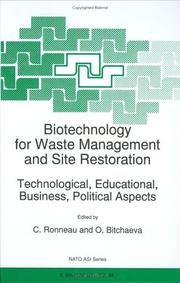| Listing 1 - 1 of 1 |
Sort by
|

ISBN: 0792347692 940107156X 9400914679 9780792347699 Year: 1997 Volume: 34 Publisher: Dordrecht: Kluwer,
Abstract | Keywords | Export | Availability | Bookmark
 Loading...
Loading...Choose an application
- Reference Manager
- EndNote
- RefWorks (Direct export to RefWorks)
Biotechnology for Waste Management and Site Restoration covers: waste management - solid, gaseous, liquid; site restoration - radioactivity, organics, toxic metals; educational, economic, social and business aspects; and international collaboration. International collaboration is growing apace and many concrete projects have been started. The body of knowledge is growing. Over the long term, it is envisaged that this international collaboration will result in a long-term scientific and technological strategy, new technologies and alternative solutions, and practical implementations of biotechnology for the nuclear and industrial sectors of the economy.
Bioremediation --- Congresses. --- Congresses --- Monograph --- Bioremediation. --- ORGANIC POLLUTANTS --- Radioactive wastes. --- Biodepollution --- Biotechnology. --- Site restoration --- Biomass. --- Site remediation --- Nuclear fallout --- Biosolution --- Heavy metals. --- Gases. --- Fluids --- Matter --- Gas laws (Physical chemistry) --- Pneumatics --- Toxic metals --- Metals --- Poisons --- Mass (Physics) --- Biology --- Chemical engineering --- Genetic engineering --- Nuclear wastes --- Radwastes --- Wastes, Nuclear --- Wastes, Radioactive --- Hazardous wastes --- Nuclear engineering --- Radioactive substances --- Environmental biotechnology --- Biodegradation --- Pollution --- Properties --- Soil science. --- Soil conservation. --- Waste management. --- Environmental management. --- Soil Science & Conservation. --- Waste Management/Waste Technology. --- Environmental Management. --- Environmental stewardship --- Stewardship, Environmental --- Environmental sciences --- Management --- Conservation of soil --- Erosion control, Soil --- Soil erosion --- Soil erosion control --- Soils --- Agricultural conservation --- Soil management --- Pedology (Soil science) --- Agriculture --- Earth sciences --- Control --- Prevention --- Conservation --- Bioremediation - Congresses.
| Listing 1 - 1 of 1 |
Sort by
|

 Search
Search Feedback
Feedback About UniCat
About UniCat  Help
Help News
News